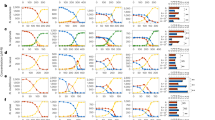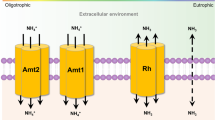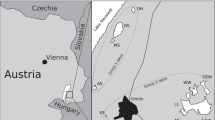Abstract
Ammonia- and nitrite-oxidizing microorganisms are collectively responsible for the aerobic oxidation of ammonia via nitrite to nitrate and have essential roles in the global biogeochemical nitrogen cycle. The physiology of nitrifiers has been intensively studied, and urea and ammonia are the only recognized energy sources that promote the aerobic growth of ammonia-oxidizing bacteria and archaea. Here we report the aerobic growth of a pure culture of the ammonia-oxidizing thaumarchaeote Nitrososphaera gargensis1 using cyanate as the sole source of energy and reductant; to our knowledge, the first organism known to do so. Cyanate, a potentially important source of reduced nitrogen in aquatic and terrestrial ecosystems2, is converted to ammonium and carbon dioxide in Nitrososphaera gargensis by a cyanase enzyme that is induced upon addition of this compound. Within the cyanase gene family, this cyanase is a member of a distinct clade also containing cyanases of nitrite-oxidizing bacteria of the genus Nitrospira. We demonstrate by co-culture experiments that these nitrite oxidizers supply cyanase-lacking ammonia oxidizers with ammonium from cyanate, which is fully nitrified by this microbial consortium through reciprocal feeding. By screening a comprehensive set of more than 3,000 publically available metagenomes from environmental samples, we reveal that cyanase-encoding genes clustering with the cyanases of these nitrifiers are widespread in the environment. Our results demonstrate an unexpected metabolic versatility of nitrifying microorganisms, and suggest a previously unrecognized importance of cyanate in cycling of nitrogen compounds in the environment.
This is a preview of subscription content, access via your institution
Access options
Subscribe to this journal
Receive 51 print issues and online access
$199.00 per year
only $3.90 per issue
Buy this article
- Purchase on Springer Link
- Instant access to full article PDF
Prices may be subject to local taxes which are calculated during checkout



Similar content being viewed by others
References
Hatzenpichler, R. et al. A moderately thermophilic ammonia-oxidizing crenarchaeote from a hot spring. Proc. Natl Acad. Sci. USA 105, 2134–2139 (2008)
Kamennaya, N. A. & Post, A. F. Distribution and expression of the cyanate acquisition potential among cyanobacterial populations in oligotrophic marine waters. Limnol. Oceanogr. 58, 1959–1971 (2013)
Qian, M., Eaton, J. W. & Wolff, S. P. Cyanate-mediated inhibition of neutrophil myeloperoxidase activity. Biochem. J. 326, 159–166 (1997)
Purcarea, C. et al. Aquifex aeolicus aspartate transcarbamoylase, an enzyme specialized for the efficient utilization of unstable carbamoyl phosphate at elevated temperature. J. Biol. Chem. 278, 52924–52934 (2003)
Ubalua, A. O. Cyanogenic glycosides and the fate of cyanide in soil. Aust. J. Crop. Sci. 4, 223–237 (2010)
Widner, B., Mulholland, M. R. & Mopper, K. Chromatographic determination of nanomolar cyanate concentrations in estuarine and sea waters by precolumn fluorescence derivatization. Anal. Chem. 85, 6661–6666 (2013)
Rees, A. P., Woodward, E. M. S. & Joint, I. Concentrations and uptake of nitrate and ammonium in the Atlantic Ocean between 60 degrees N and 50 degrees S. Deep Sea Res. II 53, 1649–1665 (2006)
Rocap, G. et al. Genome divergence in two Prochlorococcus ecotypes reflects oceanic niche differentiation. Nature 424, 1042–1047 (2003)
Luque-Almagro, V. M. et al. Characterization of the Pseudomonas pseudoalcaligenes CECT5344 cyanase, an enzyme that is not essential for cyanide assimilation. Appl. Environ. Microbiol. 74, 6280–6288 (2008)
Kamennaya, N. A., Chernihovsky, M. & Post, A. F. The cyanate utilization capacity of marine unicellular Cyanobacteria. Limnol. Oceanogr. 53, 2485–2494 (2008)
Bock, E. Growth of nitrobacter in the presence of organic matter. II. Chemoorganotrophic growth of Nitrobacter agilis. Arch. Microbiol. 108, 305–312 (1976)
Bock, E., Schmidt, I., Stuven, R. & Zart, D. Nitrogen loss caused by denitrifying Nitrosomonas cells using ammonium or hydrogen as electron-donors and nitrite as electron-acceptor. Arch. Microbiol. 163, 16–20 (1995)
Hommes, N. G., Sayavedra-Soto, L. A. & Arp, D. J. Chemolithoorganotrophic growth of Nitrosomonas europaea on fructose. J. Bacteriol. 185, 6809–6814 (2003)
Mussmann, M. et al. Thaumarchaeotes abundant in refinery nitrifying sludges express amoA but are not obligate autotrophic ammonia oxidizers. Proc. Natl Acad. Sci. USA 108, 16771–16776 (2011)
Koch, H. et al. Growth of nitrite-oxidizing bacteria by aerobic hydrogen oxidation. Science 345, 1052–1054 (2014)
Tourna, M. et al. Nitrososphaera viennensis, an ammonia oxidizing archaeon from soil. Proc. Natl Acad. Sci. USA 108, 8420–8425 (2011)
Qin, W. et al. Marine ammonia-oxidizing archaeal isolates display obligate mixotrophy and wide ecotypic variation. Proc. Natl Acad. Sci. USA 111, 12504–12509 (2014)
Spang, A. et al. The genome of the ammonia-oxidizing Candidatus Nitrososphaera gargensis: insights into metabolic versatility and environmental adaptations. Environ. Microbiol. 14, 3122–3145 (2012)
Stieglmeier, M. et al. Nitrososphaera viennensis gen. nov., sp nov., an aerobic and mesophilic, ammonia-oxidizing archaeon from soil and a member of the archaeal phylum Thaumarchaeota. Int. J. Syst. Evol. Microbiol. 64, 2738–2752 (2014)
Maeda, S. & Omata, T. Nitrite transport activity of the ABC-type cyanate transporter of the cyanobacterium Synechococcus elongatus. J. Bacteriol. 191, 3265–3272 (2009)
Muñoz-Centeno. M. C, Paneque, A. & Cejudo, F. J. Cyanate is transported by the nitrate permease in Azotobacter chroococcum. FEMS Microbiol. Lett. 137, 91–94 (1996)
Schramm, A., de Beer, D., van den Heuvel, J. C., Ottengraf, S. & Amann, R. Microscale distribution of populations and activities of Nitrosospira and Nitrospira spp. along a macroscale gradient in a nitrifying bioreactor: Quantification by in situ hybridization and the use of microsensors. Appl. Environ. Microbiol. 65, 3690–3696 (1999)
Maixner, F. et al. Nitrite concentration influences the population structure of Nitrospira-like bacteria. Environ. Microbiol. 8, 1487–1495 (2006)
Koops, H. P., Bottcher, B., Moller, U. C., Pommereningroser, A. & Stehr, G. Classification of eight new species of ammonia-oxidizing bacteria: Nitrosomonas communis sp. nov., Nitrosomonas ureae sp. nov., Nitrosomonas aestuarii sp. nov., Nitrosomonas marina sp. nov., Nitrosomonas nitrosa sp. nov., Nitrosomonas eutropha sp. nov., Nitrosomonas oligotropha sp. nov. and Nitrosomonas halophila sp. nov. J. Gen. Microbiol. 137, 1689–1699 (1991)
Markowitz, V. M. et al. IMG 4 version of the integrated microbial genomes comparative analysis system. Nucleic Acids Res. 42, D560–D567 (2014)
Daims, H., Nielsen, J. L., Nielsen, P. H., Schleifer, K. H. & Wagner, M. In situ characterization of Nitrospira-like nitrite oxidizing bacteria active in wastewater treatment plants. Appl. Environ. Microbiol. 67, 5273–5284 (2001)
Alonso-Sáez, L. et al. Role for urea in nitrification by polar marine Archaea. Proc. Natl Acad. Sci. USA 109, 17989–17994 (2012)
Suchard, M. A. & Redelings, B. D. BAli-Phy: simultaneous Bayesian inference of alignment and phylogeny. Bioinformatics 22, 2047–2048 (2006)
Edgar, R. C. Search and clustering orders of magnitude faster than BLAST. Bioinformatics 26, 2460–2461 (2010)
Lebedeva, E. V. et al. Enrichment and genome sequence of the group I.1a ammonia-oxidizing Archaeon “Ca. Nitrosotenuis uzonensis” representing a clade globally distributed in thermal habitats. PLoS ONE 8, e80835 (2013)
Widdel, F. Anaerober Abbau von Fettsäuren und Benzoesäure durch neu isolierte Arten Sulfat-reduzierender Bakterien. Dissertation, Universität Göttingen (1980)
Ehrich, S., Behrens, D., Lebedeva, E., Ludwig, W. & Bock, E. A new obligately chemolithoautotrophic, nitrite-oxidizing bacterium, Nitrospira moscoviensis sp. nov. and its phylogenetic relationship. Arch. Microbiol. 164, 16–23 (1995)
Strickland, J. D. H. & Parsons, T. R. A Practical Handbook of Seawater Analysis. (Fisheries Research Board of Canada, 1972)
Kandeler, E. & Gerber, H. Short-term assay of soil urease activity using colorimetric determination of ammonium. Biol. Fertil. Soils 6, 68–72 (1988)
Guilloton, M. & Karst, F. A spectrophotometric determination of cyanate using reaction with 2-aminobenzoic acid. Anal. Biochem. 149, 291–295 (1985)
Mobarry, B. K., Wagner, M., Urbain, V., Rittmann, B. E. & Stahl, D. A. Phylogenetic probes for analyzing abundance and spatial organization of nitrifying bacteria. Appl. Environ. Microbiol. 62, 2156–2162 (1996)
Schiffmann, C. L. et al. Proteome profile and proteogenomics of the organohalide-respiring bacterium Dehalococcoides mccartyi strain CBDB1 grown on hexachlorobenzene as electron acceptor. J. Proteomics 98, 59–64 (2014)
Käll, L., Canterbury, J. D., Weston, J., Noble, W. S. & MacCoss, M. J. Semi-supervised learning for peptide identification from shotgun proteomics datasets. Nature Methods 4, 923–925 (2007)
Gallant, R. Nonlinear Equation Estimation 610 (John Wiley and Sons, 1987)
Henningsen, A. & Hamann, J. D. systemfit: A package for estimating systems of simultaneous equations in R. J. Stat. Softw. 23, 1–40 (2007)
Team, R. D. C. R. A language and environment for statistical computing. Proc. Natl Acad. Sci. USA http://www.R-project.org/ (2011)
DeMartini, N., Murzin, D. Y., Forssen, M. & Hupa, M. Kinetics of cyanate decomposition in alkaline solutions of high ionic strength: The catalytic effect of bicarbonate. Ind. Eng. Chem. Res. 43, 4815–4821 (2004)
Taillades, J. et al. A pH-dependent cyanate reactivity model: application to preparative N-carbamoylation of amino acids. J. Chem. Soc. Perk. T. 2, 1247–1254 (2001)
UniProt Consortium. Activities at the Universal Protein Resource (UniProt). Nucleic Acids Res. 42, D191–D198 (2014)
Katoh, K. & Standley, D. M. MAFFT multiple sequence alignment software version 7: improvements in performance and usability. Mol. Biol. Evol. 30, 772–780 (2013)
Altschul, S. F., Gish, W., Miller, W., Myers, E. W. & Lipman, D. J. Basic Local Alignment Search Tool. J. Mol. Biol. 215, 403–410 (1990)
Marchler-Bauer, A. et al. CDD: conserved domains and protein three-dimensional structure. Nucleic Acids Res. 41, D348–D352 (2013)
Acknowledgements
We thank E. Lebedeva for efforts in purifying N. gargensis, M. Mooshammer for help with cyanate analytics, K. Eismann and B. Scheer for help with the proteomic analysis, and M. Schmid for performing the FISH experiment. A. Pommerening-Röser is acknowledged for providing the Nitrosomonas nitrosa Nm90 strain. M.Pa., M.Po., A.G., P.H., and M.W. were supported by the European Research Council Advanced Grant project NITRICARE 294343 (to M.W). H.D., H.K., and D.B. were supported by the Austrian Science Fund (FWF, grants P25231-B21 and P26127-B20). We are grateful for use of the analytical facilities of the Centre for Chemical Microscopy (ProVIS) at the Helmholtz Centre for Environmental Research, which is supported by European Regional Development Funds (EFRE–Europe funds Saxony) and the Helmholtz Association. M.vB. was partially funded by the Collaborative Research Centre AquaDiva of the German Research Foundation.
Author information
Authors and Affiliations
Contributions
M.Pa., P.H. and A.G. performed experiments with N. gargensis; C.H. and I.L. carried out analysis of metagenomic data sets and proteomics data; N.J. and M.vB. performed proteomics measurements and data analysis; M.Po. and H.K. performed all experiments with N. moscoviensis; H.K. carried out genomic analysis of ammonia- and nitrite-oxidizing organisms; S.M.K. contributed to metagenomic data analysis; D.B. performed cyanate decomposition modelling; M.W., H.D., and M.Pa. designed the study and analysed data. M.W. wrote the paper. All authors discussed the results and commented the manuscript.
Corresponding author
Ethics declarations
Competing interests
The authors declare no competing financial interests.
Extended data figures and tables
Extended Data Figure 1 Biotic and abiotic cyanate degradation kinetics.
a, Degradation of 500 μM cyanate and utilization of ammonium by N. gargensis modelled as two consecutive first order reactions (cyanate–ammonium–nitrite). Measured data are shown as dots and error bars (mean ± s.e.m.) and model predictions with estimated rate parameters are shown as solid lines. Estimated rate constants were kcyanate−ammonium = 4.872 × 10−4 min−1 and kammonium−nitrite = 1.064 × 10−3 min−1. The abiotic hydrolysis of 500 μM cyanate in this medium was measured to be much slower than enzymatic degradation (kcyanate−hydrolysis = 8.71 × 10−5 min−1). b, The abiotic degradation of low (100 nM; left) and high (500 µM; right) concentrations of isocyanic acid/cyanate across a range of temperatures and pH. Degradation was modelled using a well-established model of three first-order reactions: (1) hydronium-ion-catalysed hydrolysis of isocyanic acid (k1 = e25.97 × e−7201.29/T); (2) direct hydrolysis of isocyanic acid (k2 = e72.30 × e−21646.66/T); and (3) direct hydrolysis of cyanate42 (k3 = e22.23 × e−8725/T). The log-transformed degradation rates are shown (as min−1). The conditions that were used to test cyanate degradation by N. gargensis are marked with a cross.
Extended Data Figure 2 Nitrososphaera gargensis grows on cyanate.
16S rRNA gene copy numbers of N. gargensis as determined by qPCR at three different time points during the experiment shown in Fig. 1. For comparison, the respective gene copy numbers after growth in medium with 0.5 mM ammonium are displayed. The gene copy numbers increased 6.49-fold during growth on ammonium and 4.98-fold during growth on cyanate over 263 h. Columns show means, error bars show s.d. of four biological replicates. Significance was calculated by a paired t-test.
Extended Data Figure 3 Cyanase increase upon exposure of N. gargensis to cyanate.
Fold-increase and -decrease of the 35 most affected proteins after 48 h exposure of N. gargensis to 0.5 mM cyanate (in comparison to t = 0 of N. gargensis biomass that had not been exposed to cyanate). Experiments were performed in three biological replicates. Proteins with a significant difference in expression are colour coded. Significance of difference was calculated by a one-sample t-test on log-fold induction, with the Benjamini–Hochberg false discovery rate set to 0.05 (P value cutoff 0.00878). For the proteomic analyses, 10 µg protein and 500 ng peptide lysate per sample was used. Protein abundances within a sample were normalized by dividing the peak area for a given protein by the median peak area for all detected proteins. Note that during growth on cyanate, N. gargensis experiences much lower concentrations of ammonium that during growth on ammonium in batch culture, which probably influences the expression patterns of some of the listed proteins.
Extended Data Figure 4 Conversion of 0.05 mM cyanate by N. gargensis.
a, Concentration changes of cyanate, ammonium, and nitrite caused by N. gargensis in a mineral medium containing 0.05 mM cyanate as the only source of energy and reductant. b, Abiotic control experiment. All experiments were performed in four biological replicates and the chemical measurements were done in three technical replicates (averaged). Data points are mean values of four biological replicates, error bars show s.d.
Extended Data Figure 5 Nitrospira moscoviensis has a functional cyanase.
Concentration changes of cyanate and ammonium during incubation of N. moscoviensis (27.6 ± 3.9 µg ml−1 protein) in a mineral medium containing cyanate, but no nitrite. Results from a control experiment with identical amounts of dead biomass of N. moscoviensis are also displayed. All experiments were performed in triplicate and the chemical measurements from each replicate were done in three replicates. Data points are mean values, error bars show s.d. Asterisks indicate statistical significance between N. moscoviensis and dead biomass, *P < 0.05, ***P < 0.001. Significance was assessed by two-way analysis of variance (ANOVA) including Tukey’s honest significant difference (HSD) test.
Extended Data Figure 6 Decelerating effect of increased cyanate concentrations on nitrite oxidation by N. moscoviensis.
Biomass was incubated for 60 h in medium containing 1 mM nitrite and cyanate concentrations ranging from 0 mM to 5 mM, and nitrite oxidation was monitored. Incubations were performed in duplicates.
Extended Data Figure 7 Nitrosomonas nitrosa Nm90 has no cyanase activity and is not inhibited by 1 mM cyanate.
Concentration of nitrite during incubation of N. nitrosa in a mineral medium containing: 1 mM ammonium (filled circles); 1 mM cyanate (filled squares); 1 mM cyanate and 1 mM ammonium (open circles); 10 mM ammonium (filled triangles); and 1 mM cyanate and 10 mM ammonium (open triangles). All experiments were performed in three biological replicates, data points are mean values, error bars show s.d.
Extended Data Figure 8 Reciprocal feeding of ammonia and nitrite oxidizers during cyanate conversion.
As activities differed between biological replicates (as often observed for nitrifying strains that are very sensitive to rubber stoppers, contaminants on glass material, etc.), data are displayed for each replicate individually. Concentrations of cyanate, ammonium, nitrite, and nitrate are displayed as bar (left) and line charts (right) during the growth of the cyanase-negative ammonium-oxidizing bacterium Nitrosomonas nitrosa Nm90 and the cyanase-positive nitrite oxidizer N. moscoviensis in a mineral medium containing 1 mM cyanate (a–c) or 1 mM cyanate and 1 mM ammonium (d–f). Data points are mean values, error bars show s.d. of three technical replicates.
Extended Data Figure 9 Abiotic controls for the reciprocal-feeding experiment.
See also Fig. 2 and Extended Data Fig. 8. Concentration changes of cyanate, ammonium, nitrite, and nitrate during 168 h of incubation under similar conditions to the biotic experiments: mineral medium containing 1 mM cyanate (left) or 1 mM cyanate and 1 mM ammonium (right). The rate of cyanate decay is much slower than in biotic setups (see Extended Data Fig. 8). Cyanate decay in the presence of ammonium led to formation of a product other than ammonium (possibly carbamylate). No nitrite or nitrate was formed abiotically. Data points are mean values, error bars show s.d. of three technical replicates.
Supplementary information
Supplementary Information
This file contains a short formal description of Nitrososphaera gargensis sp. nov., as a pure culture of this organism is first described in this manuscript. (PDF 117 kb)
Rights and permissions
About this article
Cite this article
Palatinszky, M., Herbold, C., Jehmlich, N. et al. Cyanate as an energy source for nitrifiers. Nature 524, 105–108 (2015). https://doi.org/10.1038/nature14856
Received:
Accepted:
Published:
Issue Date:
DOI: https://doi.org/10.1038/nature14856
This article is cited by
-
Taurine as a key intermediate for host-symbiont interaction in the tropical sponge Ianthella basta
The ISME Journal (2023)
-
Nitrification and beyond: metabolic versatility of ammonia oxidising archaea
The ISME Journal (2023)
-
Nitrogen and phosphorous acquisition strategies drive coexistence patterns among archaeal lineages in soil
The ISME Journal (2023)
-
Diverse ecophysiological adaptations of subsurface Thaumarchaeota in floodplain sediments revealed through genome-resolved metagenomics
The ISME Journal (2022)
-
Diversity, prevalence, and expression of cyanase genes (cynS) in planktonic marine microorganisms
The ISME Journal (2022)
Comments
By submitting a comment you agree to abide by our Terms and Community Guidelines. If you find something abusive or that does not comply with our terms or guidelines please flag it as inappropriate.



